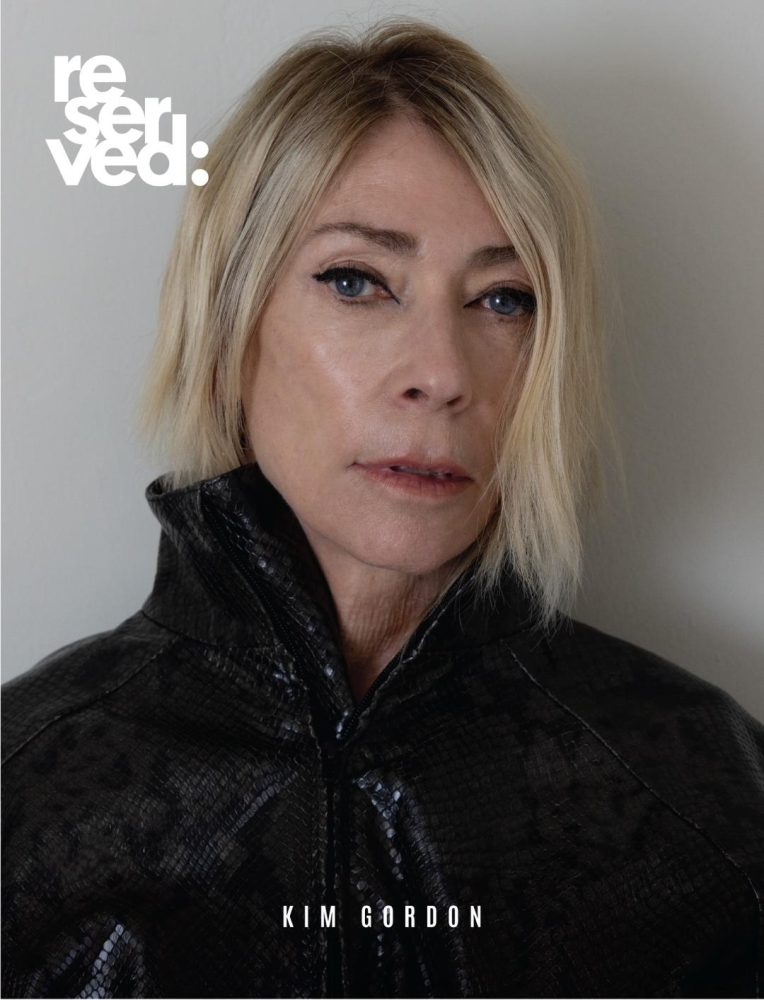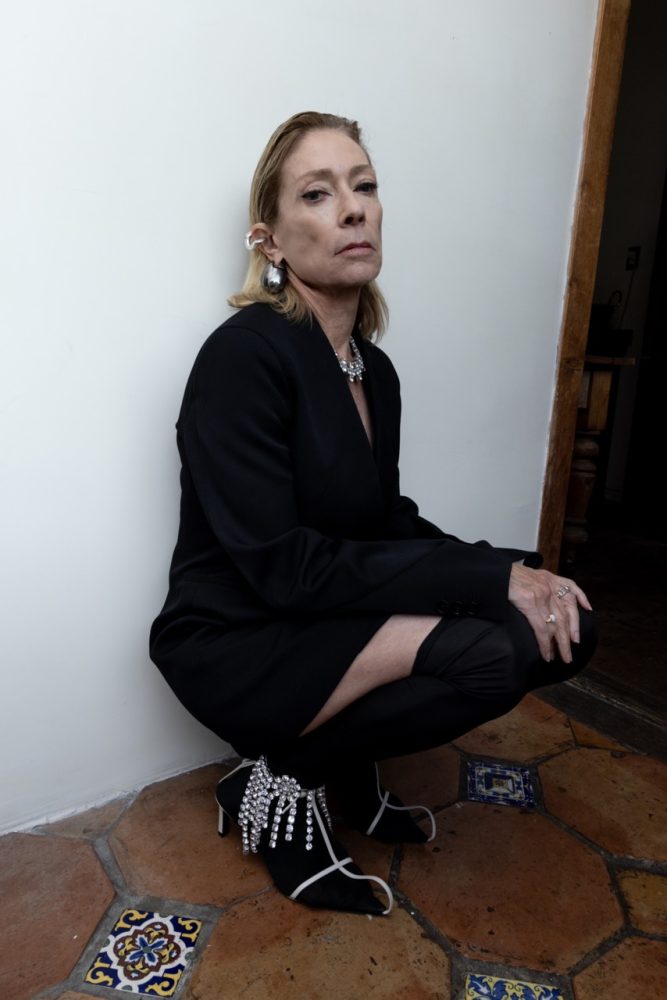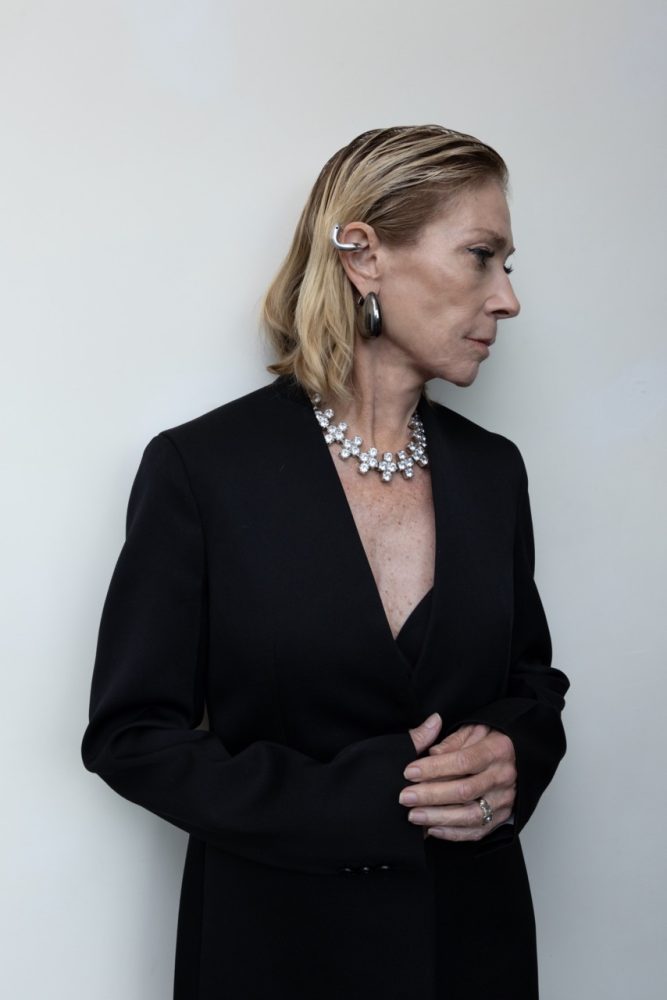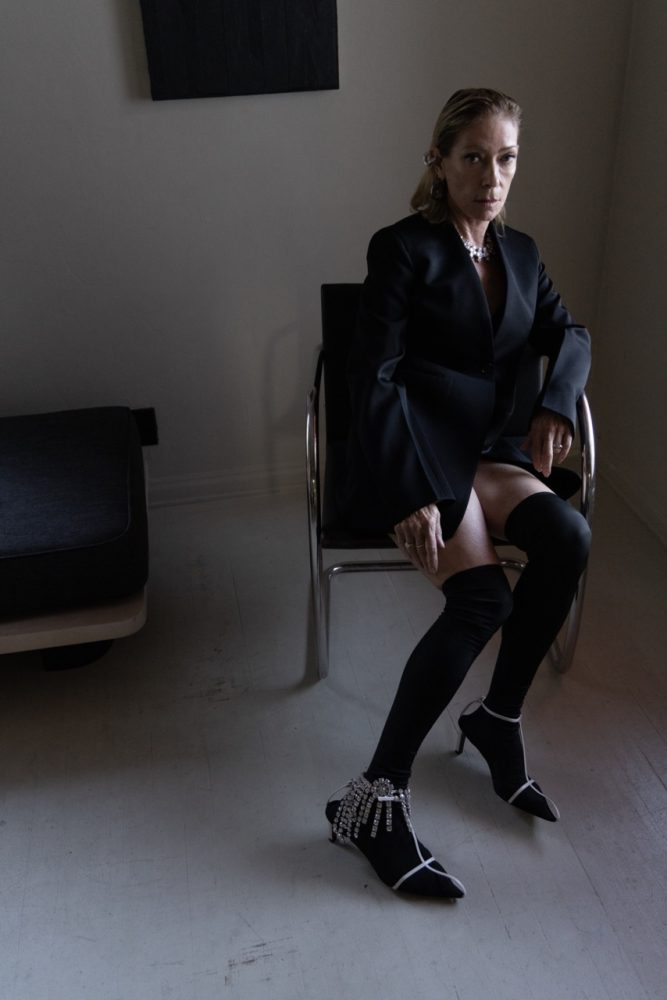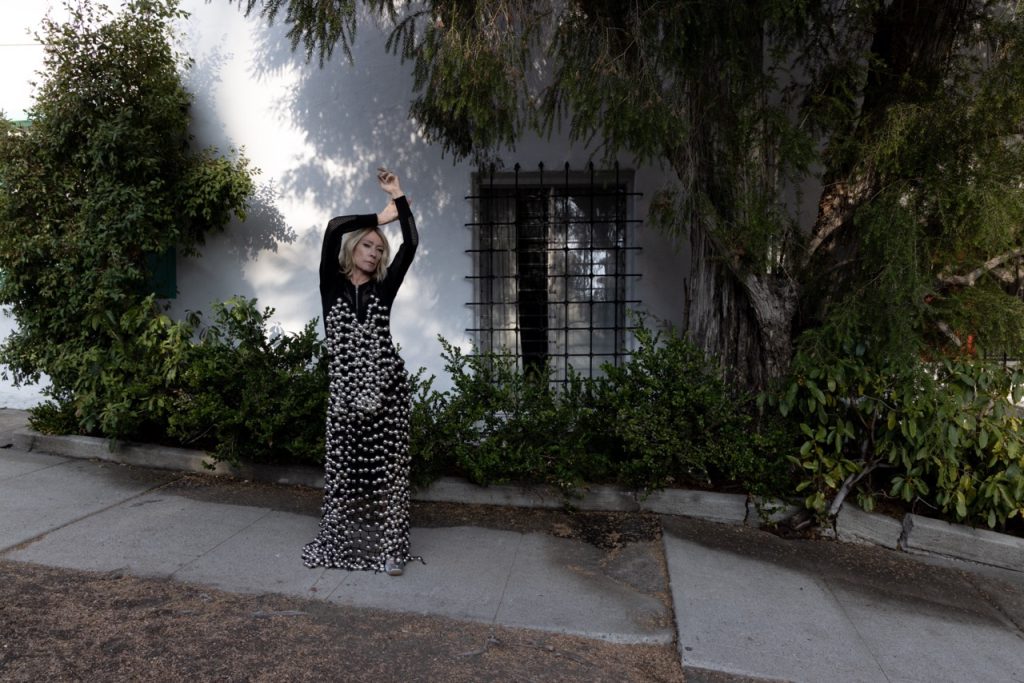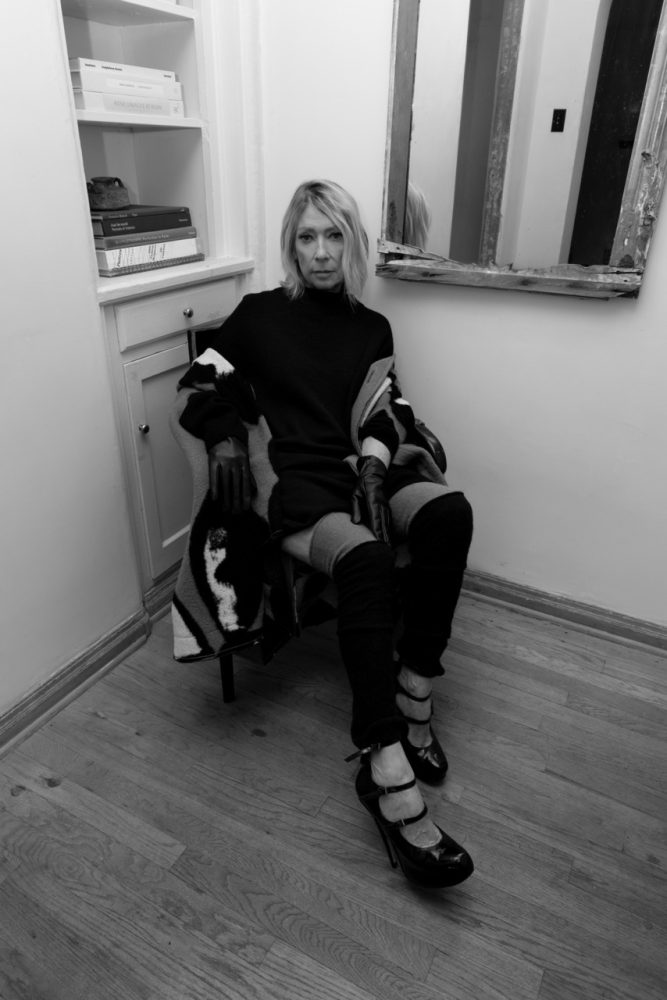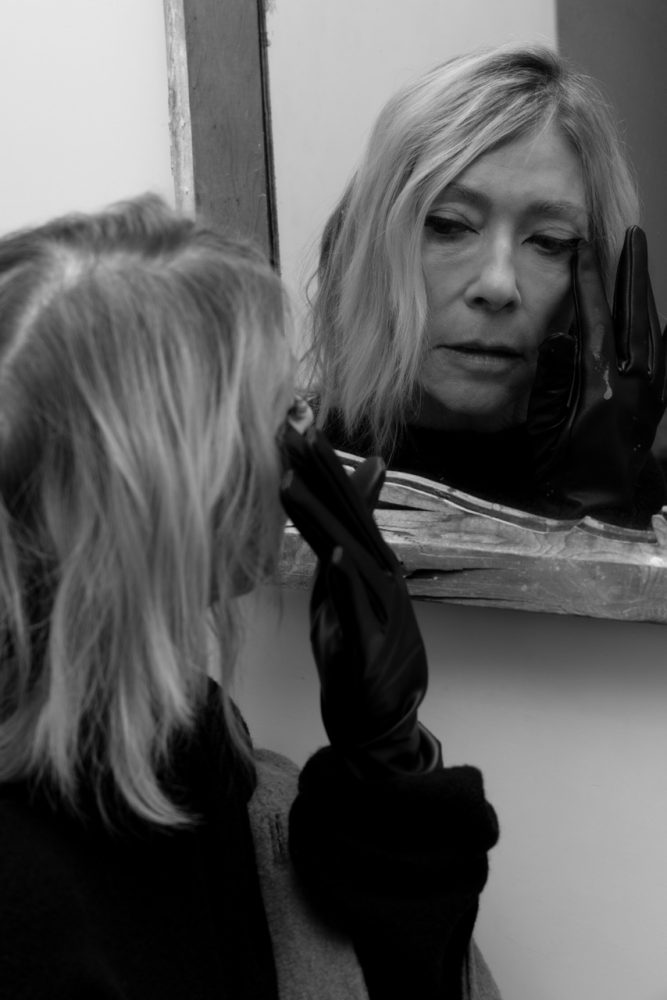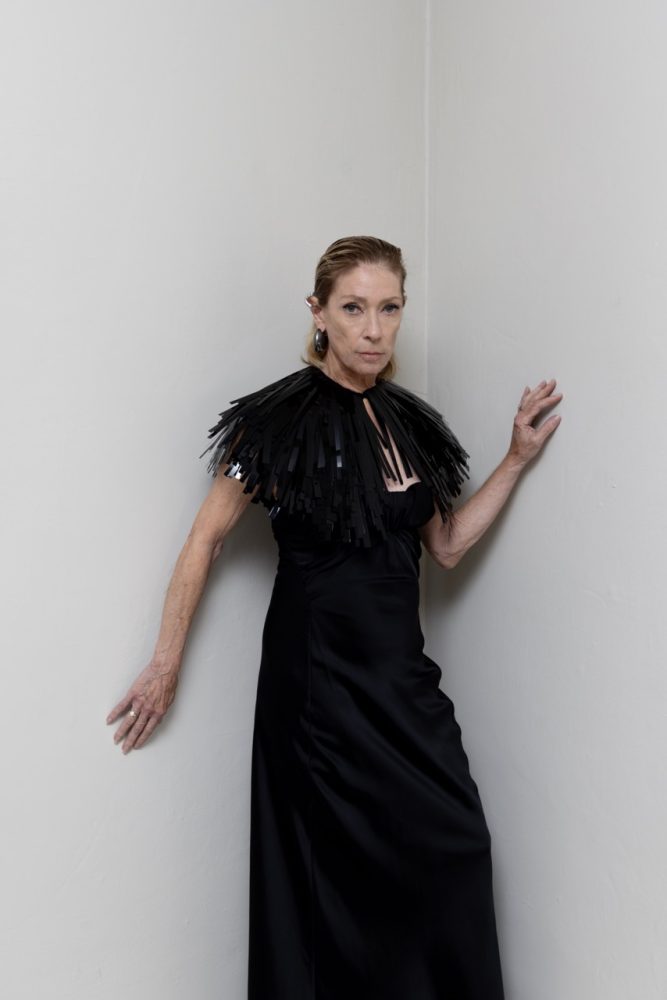
Kim Gordon’s unorthodox and uncompromising work as an author, visual artist, rock star, and general style-icon has outlasted countless cycles of pop culture ephemera and near cemented her name as a signifier of Platonic-ideal level “cool.”
Gordon’s The Collective (her 2024 album with collaborator/producer Justin Raisen) fused experimental hip-hop production with noise music while also managing to snag two Grammy nominations (Best Alternative Music Album, with single “BYE BYE” up for Best Alternative Music Performance).
Kim Gordon joined RESERVED to share her perspective on LA’s real estate scene, cultural myth-making, classic television, and creative evolution.
- Kim Gordon wears RODARTE dress and Talent’s own MAISON MARGIELA shoes.
Reserved: Most career artists lean on greatest hits and nostalgia, they don’t make trap albums. It’s not something you see a lot.
Kim Gordon: I didn’t think that much about it, it just happened that way. I know my vocal range, I’m not a natural singer, so I’m motivated by rhythm and things like that. I like to work with beats or rhythms, and I’ve always liked rap, the recycling aspect of it. How anyone can do it.
You started in the visual arts, only to find yourself known primarily for music. Do those worlds overlap for you?
KG: I mean, I don’t think I’m sculpting… but I’m sitting in my studio, actually. I think more in terms of movies than anything. I do still see myself primarily as a visual artist, in that I think about things going on around me, sociologically.
You were raised in LA and currently living here again. We just survived a massive series of wildfires in Alta Dena, the Palisades, Topanga, Hollywood… how do things like that influence your work?
KG: Well, I don’t literally respond to events so much… but I am interested in real estate. Since the fires, there’s this whole idea of developers rushing in. (Rick) Caruso, who makes malls, saved his mall with private firefighters. I don’t want to say, but he’s probably buying real estate from people with burned out houses.
I grew up in LA, and driving down the street you can see so many styles of architecture. It’s just so weird. You see mid-western housing style, or a wagon wheel ranch-style house, or a fake colonial. All the ways people customize their houses… that’s what California’s supposed to be about, the freedom to express your individuality or something. That’s the myth.
LA developed through architecture and real estate, while most cities develop through manufacturing. Even in the 1860s they were advertising to the Midwest, saying “come to paradise.” I’ve thought about it, and expressed that through artwork I’ve made.
The business of LA is myth-manufacturing.
KG: McDonnell Douglas built this huge suburb development in the 50s called Lakewood. Joan Didion wrote about it. It was this kind of fake middle class neighborhood for vets returning from the war, but as time went on and the aircraft manufacturing left, it went downhill. Now, there are all kinds of luxury condo developments and tract houses with names… I’m interested in the names, in the branding and packaging of it all, the lifestyle.
- Kim Gordon wears JIL SANDER dress, coat, shoes and jewelry.
- Kim Gordon wears JIL SANDER dress, coat, and jewelry.
- Kim Gordon wears JIL SANDER dress, coat, shoes and jewelry.
What are your favorite corners of the city right now?
KG: I grew up in West LA. To me, it was super boring, but my mother would say “don’t ever buy a house in the hills, because there are fires and mudslides.” She’s an incredibly practical person. But I like the east-side. There are old, interesting buildings. There’s this gallery I had a show at last June, O-Town House. It’s in a building called the Granada that goes beyond the usual Mediterranean style, it’s “fantasy Spanish.” It was created as an experiment in live-work spaces, with an open atrium that’s got pine trees. It’s near MacArthur Park, which is where Otis (College of Art and Design) was when I went there.
You mention thinking in terms of movies, have you thought about directing?
KG: I’d like to make another art video… and I’ve been working on a screenplay that’s roughly based on my life, but I’ve been busy with other things.
It’s funny, growing up with TV in LA. There’s this show – Mr. Ed – about a talking horse. This guy, he’s an architect, has his office in the garage, and his door is cut in half so the horse can stick his head through. And when I was a kid I was obsessed with this show, 77 Sunset Strip. It’s about detective agency with a covered driveway where this mascot guy – Kooky – would take your car. For years, I’d drive around and look for that place.
It’s hard to separate what LA is now from the bits that are left. Maybe it’s nostalgia, but LA is all about signage and store facades that are always changing… but then there are certain streets, like Western. They’ve made it into a kind of arts district, but it used to be the jankiest street. And it kind of still is, I mean those mattress stores are still there. So I’m interested in how the DNA of a street or a neighborhood doesn’t change.
Do you drive a lot these days?
KG: I honestly try not to.
TV, art, movies, music… you frame things through art, and making art. You toured for years, and you’ve got shows coming up. That aspect of structured time, did it change the way you looked at the non-music parts of your life?
KG: I’ve been writing another chapter for my memoir, which is getting reissued this year for its 10 year anniversary. I was thinking about how, looking back, I could think of my life in terms of tours. It’s weird, because I really never wanted to be a musician. I fell into it. When I’m not on tour I can’t even remember the names of my songs. I mean, I have so many great memories from the last year of touring with the band, I love those women. But when I’m not doing it, it feels separate for me. It’s not something I’m even trying to compartmentalize, it’s just I’m not a part of the music industry. It was weird going to the Grammys, being involved with all that. I felt like an interloper or something.
- Kim Gordon wears MAISIE WILEN dress, BALMAIN bodysuit available at Paume Los Angeles, and SARA WONG shoes.
- Kim Gordon wears ISSEY MIYAKE coat, dress, leg warmers, and gloves, VIVIENNE WESTWOOD shoes available at Paume Los Angeles.
You didn’t come from a showbiz family, you came from an academic family, right?
KG: Yeah, and they really didn’t like show business.
Your father was a professor of sociology. Did you ever find yourself looking at life in a band or on tour through that kind of lens? The rituals and customs of it all?
KG: I’ve thought a lot about male bonding, but mostly when I’ve been around it. Tour can be super boring, so I try to make something out of it, like taking pictures in hotels of weird light fixtures.
Most career artists lean on a specific creative identity, or a few signature works and that’s that. Whereas you’ve had a presence in music, in painting, in acting over the years, but each time you step out it’s a kind of reinvention. It’s less about a specific aesthetic, more about trying things out across different mediums. Is that a deliberate part of your approach?
KG: I don’t know what else I would do. I go back and forth between making art and making music. When I moved to LA, aside from playing with Bill Nace and Body/Head (Gordon and Nace’s improv guitar + bass duo) I didn’t have plans to make a solo record. I was just going to do art, so the first solo record was just “let’s see what comes out.” It was all the influences I’ve always had, from early no-wave bands, 80s and 90s hip-hop, minimalist rhythmic music, and playing in Sonic Youth, the open guitar tunings I still use. When I played with Nirvana (for the FireAid LA benefit concert) that was the first time I’d played bass since the last Sonic Youth show. It’s a difficult instrument for improv.
I kind of intuitively move through life, and sometimes I’ll say “I should do this now because I don’t have forever.” It was Justin Raisen who bugged me to make a record, now he’s bugging me to make another, so now I’m trying to figure out what kind. I think a lot of women have this kind of compulsion to please, but it’s not like I have that. I just try to keep going. It’s boring to do nothing.
- Kim Gordon wears ISSEY MIYAKE dress and gloves.
You’ve managed to keep a healthy sense of humor and curiosity about the world in spite of all that stuff. What’s your secret?
KG: For a long time, I used to get really good ideas before I fell asleep. I really tried not to think, because if I got an idea then it would haunt me, “Oh, I have to do something about this.” I didn’t want to have any ideas, because then you’re responsible for your ideas. You’re responsible. Nobody wants to feel like an adult, but I think I approach responsibility sideways. If you’re an artist, you want to foster a bit of being open in the way teenagers are, the way children are. Once you hit your 20s, you’re expected to actually do shit. Maybe it’s just daydreaming, but doing things that don’t have formulaic expectations about what something should look like or sound like, that sort of thing. I feel like I’ve managed to keep that. I mean, I’m responsible to my family, and I’m responsible to a certain extent for what I’ve done in the past, but I don’t feel totally responsible for that.
You’re not Kim Gordon in the role of Kim Gordon.
KG: I’m not an archivist. I’m not good at that sort of thing. I’m not good at doing professional kind of things in my career or my art practice.
There’s an anachronistic element to culture now, it isn’t so linear – the internet makes it relatively easy to find music and film and art stuff that used to be near impossible to source back in the days of tape trading and vhs dubs. There’s a fascination with the 90s in particular. What’s your take on that?
KG: Maybe people used to dig in the past. I understand people’s fascination with the 80s and 90s, before the internet. That’s super interesting, that kids feel the need to delve into what was. Spotify doesn’t give you information about anything, even current things. Everything’s about this culture of convenience. Technology’s not serving culture. I’m sure it’s helpful for some kinds of research, but it does not serve culture. It’s not this great library. If you look at Spotify, AI is doing that. What else is it doing with information? I have a strong mistrust of it. I’ve always been anti-corporate, and it solidifies corporate-ness.
What don’t we know about Kim Gordon that we should?
KG: I think a lot of people are intimidated by me. I’m kind of a shy person and an introvert. so I think they’re probably projecting stuff on me that’s not there.
- Kim Gordon wears JIL SANDER dress, cape, shoes and jewelry.
- Kim Gordon wears JIL SANDER dress, cape, and jewelry.


